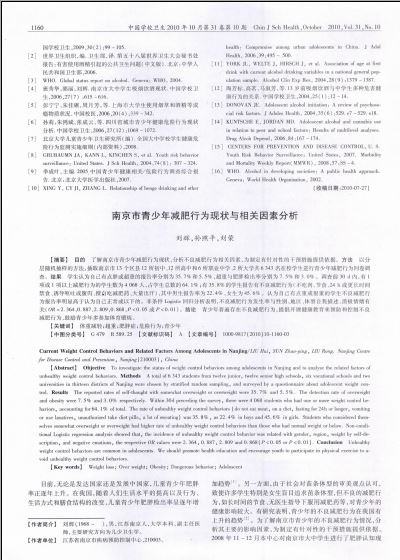南京市青少年减肥行为现状与相关因素分析(1)
 |
| 第1页 |
参见附件(1912KB,3页)。
【摘要】 目的 了解南京市青少年减肥行为现状,分析不良减肥行为相关因素,为制定有针对性的干预措施提供依据。方法 以分层随机抽样的方法,抽取南京市13个区县12所初中、12所高中和6所职业中学、2所大学共6 343名在校学生进行青少年减肥行为问卷调查。结果 学生认为自己有点胖或超重的报告率分别为35.7%和5.5%,超重与肥胖检出率分别为7.5%和3.0%。调查前30 d内,有1项或1项以上减肥行为的学生数为4 068人,占学生总数的64.1%;有35.8%的学生报告有不良减肥行为(不吃肉、节食、24 h或更长时间禁食、诱导呕吐或腹泻、擅自吃减肥药、大量出汗),其中男生报告率为22.4%,女生为45.6%。认为自己有点重或很重的学生不良减肥行为报告率明显高于认为自己正常或以下的。非条件Logistic回归分析表明,不良减肥行为发生率与性别、地区、体型自我描述、消极情绪有关(OR=2.364,0.887,2.809,0.868,P<0.05或P<0.01)。结论 青少年普遍存在不良减肥行为,提倡开展健康教育来预防和控制不良减肥行为,鼓励青少年多参加体育锻炼。
【关键词】 体重减轻;超重;肥胖症;危险行为;青少年
【中图分类号】 G 479 R 589.25 【文献标识码】 A 【文章编号】 1000-9817(2010)10-1160-03
Current Weight Control Behaviors and Related Factors Among Adolescents in Nanjing/LIU Hui, SUN Zhao-ping, LIU Rong. Nanjing Centre for Disease Control and Prevention, Nanjing(210003), China
【Abstract】 Objective To investigate the status of weight control behaviors among adolescents in Nanjing and to analyze the related factors of unhealthy weight control behaviors. Methods A total of 6 343 students from twelve junior, twelve senior high schools, six vocational schools and two universities in thirteen districts of Nanjing were chosen by stratified random sampling, and surveyed by a questionnaire about adolescent weight control. Results The reported rates of self-thought with somewhat overweight or overweight were 35.7% and 5.5%. The detection rate of overweight and obesity were 7.5% and 3.0% respectively. Within 30d preceding the survey, there were 4 068 students who had one or more weight control behaviors, accounting for 64.1% of total. The rate of unhealthy weight control behaviors (do not eat meat, on a diet, fasting for 24h or longer, vomiting or use laxatives, unauthorized take diet pills, a lot of sweating) was 35.8%, as 22.4% in boys and 45.6% in girls. Students who considered themselves somewhat overweight or overweight had higher rate of unhealthy weight control behaviors than those who had normal weight or below. Non-conditional Logistic regression analysis showed that, the incidence of unhealthy weight control behavior was related with gender, region, weight by self-description, and negative emotions, the respective OR values were 2 ......
您现在查看是摘要介绍页,详见PDF附件(1912KB,3页)。